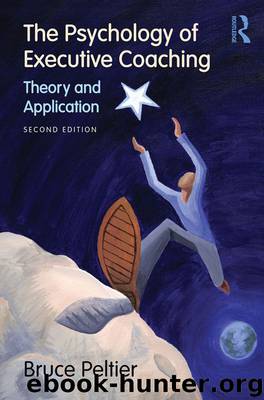The Psychology of Executive Coaching: Theory and Application by Bruce Peltier

Author:Bruce Peltier
Language: eng
Format: mobi
Publisher: Taylor and Francis
Published: 2011-04-26T14:00:00+00:00
Several of these ideas eventually led to what business people have come to refer to as out-of-the-box thinking.
Hypnosis without (Obvious) Trance
A view of hypnosis limited to trance is of little use to an executive coach, and much of the work of posttrance thinkers is complex enough to be problematic. But there is a way to define hypnosis that makes it extremely useful to business coaches. Much of what hypnosis offers coaches has this definition in common: Hypnosis is communication that bypasses critical analytic thought. We use hypnotic communication when we influence each other without making a direct request. We bypass resistance. There are many ways to do this, and some people devise ways to influence without realizing it. You may know someone who naively does this—a favorite teacher, an uncle, your mother, or even a local community leader. Somehow these people are influential, and you cannot quite put your finger on why that is so.
Some “Practical Magic”
Here are some techniques that come from the world of nontrance hypnosis. Most of them derive from multiple sources, and when a single source is known, it has been cited. Those sources can be found in the “References” and “Recommended Readings” at the end of the chapter. (Many of these ideas came from a lecture given by Paul Watzlawick at the San Francisco Academy of Hypnosis in 1988.) People who make their living in sales and those who practice neurolinguistic programming (NLP) might find them familiar.
Indirect Suggestion
You can suggest things without directly suggesting them, thereby sidestepping the resistance that accompanies injunction (“You do this”). Indirect suggestions involve a creative process, and there are many ways to do them. The key is to plant an idea or set up a situation that causes someone to do something without being specifically asked or told to do it.
For example, one way to make an indirect suggestion is to “wonder” about something. Wonder is a strange and powerful word. It tends to predict the future in a positive way and seems to direct energy and an open mind to the effort. It opens the door to possibilities. “I wonder what would happen if we didn’t go to market by the 30th” is entirely different from “You need to get this product to market by the 30th.” Other alternative ways to communicate might include “I wonder what it would take to develop a new product to do this,” “I wonder how we could get to know someone inside the Acme Company,” and “I wonder how you establish contact in a country like Vietnam?” These are not injunctions or even requests, but they plant an idea in a gentle, positive way. To plant an idea is to use indirect suggestion. When executives plant ideas, people who report to them listen and react.
You can make indirect suggestions by saying things to someone else. Imagine that you want to suggest to your client that he enhance his appearance in the business setting. Instead of saying it directly to your client (“You dress
Download
This site does not store any files on its server. We only index and link to content provided by other sites. Please contact the content providers to delete copyright contents if any and email us, we'll remove relevant links or contents immediately.
| Administration & Medicine Economics | Allied Health Professions |
| Basic Sciences | Dentistry |
| History | Medical Informatics |
| Medicine | Nursing |
| Pharmacology | Psychology |
| Research | Veterinary Medicine |
The Art of Thinking Clearly by Rolf Dobelli(9912)
The 5 Love Languages: The Secret to Love That Lasts by Gary Chapman(9278)
Mindhunter: Inside the FBI's Elite Serial Crime Unit by John E. Douglas & Mark Olshaker(8700)
Becoming Supernatural by Dr. Joe Dispenza(7834)
The Road Less Traveled by M. Scott Peck(7278)
Nudge - Improving Decisions about Health, Wealth, and Happiness by Thaler Sunstein(7242)
Mastermind: How to Think Like Sherlock Holmes by Maria Konnikova(6936)
Enlightenment Now: The Case for Reason, Science, Humanism, and Progress by Steven Pinker(6872)
Win Bigly by Scott Adams(6827)
The Way of Zen by Alan W. Watts(6289)
Factfulness: Ten Reasons We're Wrong About the World – and Why Things Are Better Than You Think by Hans Rosling(4487)
The State of Affairs by Esther Perel(4485)
Gerald's Game by Stephen King(4375)
Man's Search for Meaning by Viktor Frankl(4271)
The Confidence Code by Katty Kay(4039)
Thinking in Bets by Annie Duke(3996)
The Worm at the Core by Sheldon Solomon(3325)
Hidden Persuasion: 33 psychological influence techniques in advertising by Marc Andrews & Matthijs van Leeuwen & Rick van Baaren(3292)
Enlightenment Now by Steven Pinker(3271)
